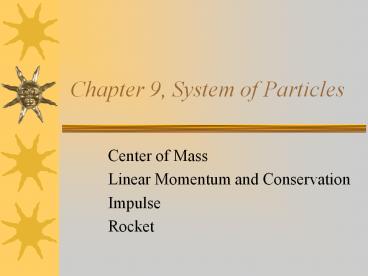Chapter 9, System of Particles PowerPoint PPT Presentation
1 / 23
Title: Chapter 9, System of Particles
1
Chapter 9, System of Particles
- Center of Mass
- Linear Momentum and Conservation
- Impulse
- Rocket
2
Center of Mass for a System of Particles
The center of mass of a body or a system of
bodies moves as though all of the mass were
concentrated there and all external forces were
applied there.
3
Where is the center of mass of this meter
stick? (a) 30cm (b) 50cm (c) 90cm
The center of mass of a symmetric, homogeneous
body must lie on its geometric center.
4
2 bodies, 1 dimension
For example, if x10, x2d, and m22m1, we find
that
5
Example 1
6
Center of Mass for a System of Particles
2 particles, 1 dimension
n particles, 3 dimensions
n particles, 3 dimensions, vector equation
7
Example 2
8
Center of Mass for a Solid Body
dm is the differential mass element
Uniform density
9
Newtons 2nd Law for a System of Particles
The center of mass moves like an imaginary
particle of mass M under the influence of the net
external force on the system.
A firework rocket explodes
10
Linear Momentum and Impulse
System
11
ImpulseLinear Momentum TheoremImpulse Force
? Duration of the force Change in Momentum
Collision of two particle-like bodies
12
Conservation of Linear Momentum
If no net external force acts on a system of
particles, the total linear momentum P of the
system cannot change.
If the component of the net external force on a
closed system is zero along an axis, then the
component of the linear momentum along that axis
cannot change.
- Closed system (no mass enters or leaves)
- Isolated system (no external net force)
13
Before collision After collision Sum of
initial momentums Sum of final momentums
14
- Closed system (no mass enters or leaves)
- Isolated system (no external net force)
Collisions in closed, isolated systems
- Elastic
- Inelastic
- Completely inelastic
- both colliding objects does not change their
shapes - total linear momentum is conserved
- total kinetic energy is conserved
- the shape of one or both of object changes
during the collision - total linear momentum is conserved
- total kinetic energy is NOT conserved
- the colliding objects stick together after the
collision - total linear momentum is conserved
- total kinetic energy is NOT conserved
15
In a closed, isolated system containing a
collision, the linear momentum of each colliding
body may change but the total momentum P of the
system cannot change, whether the collision is
elastic or inelastic.
16
Completely Inelastic Collisions in 1D
Velocity of Center of Mass
17
Sample Problem 9-8
gt
mM
18
Elastic Collisions in 1D
Equ.s (9-67), (9-68)
19
Sample Problem 9-10
20
Rocket Propulsion
A Rocket System (rocket its ejected combustion
products) is a closed, isolated system. The
rocket is accelerated as a result of the thrust
it receives from the ejected gases.
21
Rocket Equations
First rocket equation
where R is the fuel consumption rate, vrel is
the velocity of ejected fuel with respect to the
rocket M is the instantaneous mass of the
rocket a is the acceleration of the rocket T is
referred to as the thrust of the rocket engine
Second rocket equation
where vi and vf are initial and final velocities
of the rocket Mi and Mf are the initial and
final masses of the rocket
22
Summary 1
23
Summary 2
Conservation of momentum
(closed, isolated system)

